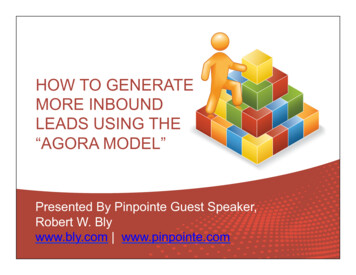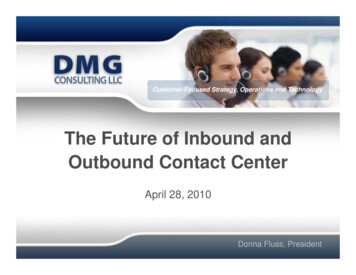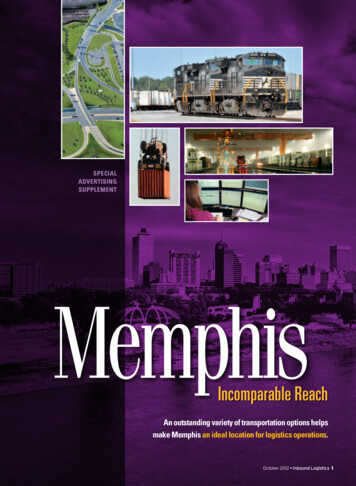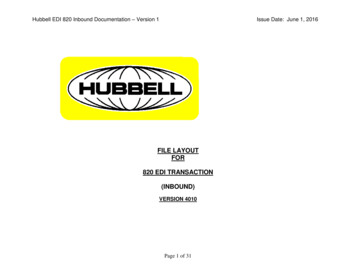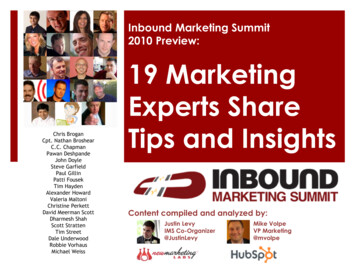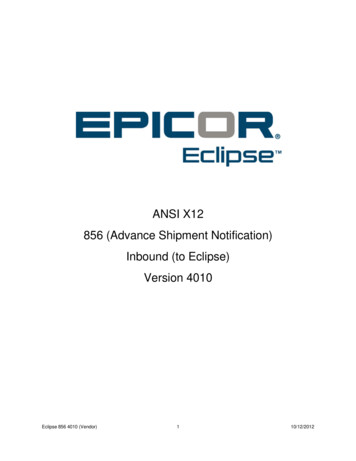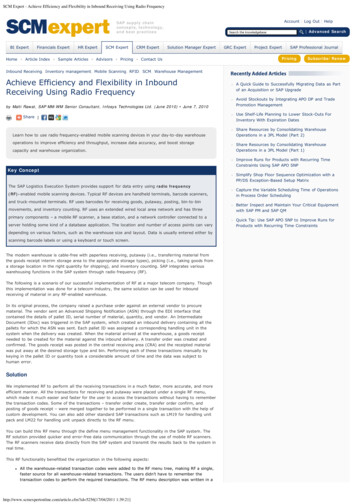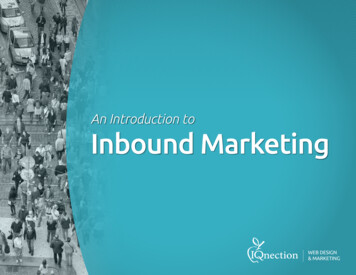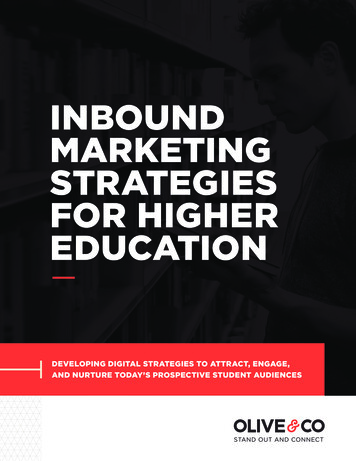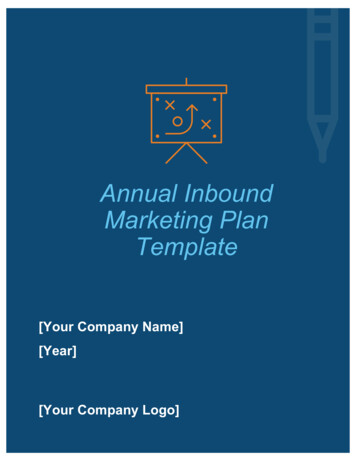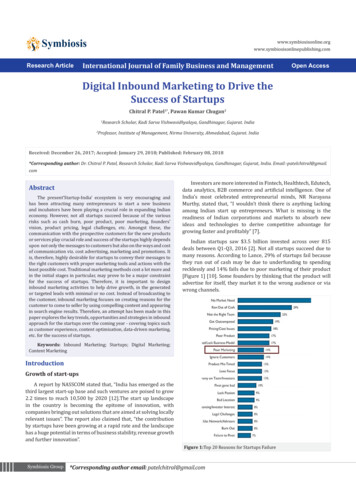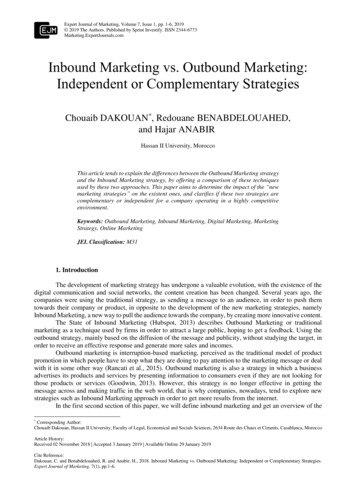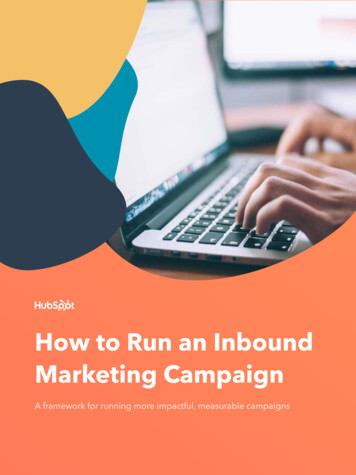
Transcription
How to Run an InboundMarketing CampaignA framework for running more impactful, measurable campaigns
Table of ContentsIntroduction--Chapter 1What Is Inbound Marketing? What is an inbound marketing campaign? See it in action: inbound campaign exampleChapter 2How to Identify a Campaign Persona What is a campaign persona? Campaign persona templates free toolChapter 3How to Brainstorm Great Campaign IdeasChapter 5How to Create Campaign Content Exploring content format options How to map your content format to thebuyer’s journeyChapter 6How to Design a Conversion Path What is a conversion path? Best practices for calls-to-action, landing pages, thank you pages, and kickback emailsChapter 7How to Prepare for Launch & Promo Tips for more effective brainstorms What to do before/after you launch How to plan promo across channels Free content promotion kit checklistChapter 4Chapter 8How to Set SMART Campaign GoalsHow to Measure & Report on Results What is a SMART goal? Free SMART goal setting template Simple/advanced marketing metrics Channel effectiveness metrics Free monthly marketing reporting templates--Conclusion
Introduction
Let’s Get to Work.According to a HubSpot Research survey, 55% of people no longer trust the companiesthey buy from as much as they used to.On top of that, organic search is getting harder and more competitive, social media promotion is becoming less effective, and marketing costs -- in general – are increasing.For marketers, this means the repeatable campaign formula that once existed (andworked) now requires more creativity and more resources to drive results than it did before.To remain competitive and keep campaign costs at bay, businesses need to start by re-4
thinking the way they approach business growth – and how that approach shapes theircampaign efforts.For years, businesses were built around the concept of the funnel – and HubSpot was noexception. Funnel businesses produce customers by attracting a wide audience that isthen qualified and nurtured until they buy. Unfortunately, funnel businesses fail to considerhow the customers they are producing can help them create new customers – and so on.At HubSpot, we discovered that if we wanted to keep growing, the funnel wasn’t the wayforward -- the flywheel model was. And when you think about your business as a flywheelinstead of a funnel, you make different decisions and adjust your strategy.5
In this guide, you’ll learn more about the flywheel model as we explore a step-by-step process for running an inbound marketing campaign in today’s competitive business landscape.You’ll walk away with a new growth framework, an actionable campaign plan, and a handful of additional free resources designed to help you launch your next campaign with confidence – and see results.Whether you want to increase leads, accelerate sales, organize yourcontacts, or better serve your customers, HubSpothas a solution to help you grow.Click here to get started with a free demo.6
Do you prefer to learn via video content?Take HubSpotAcademy’sFree Inbound CourseDiscover the fundamentals of inbound, the inbound methodology and the flywheel andlearn how to apply them to your business. The Inbound Certification Course teaches youhow to run a successful inbound business, from marketing to sales to services.Take Me to the Course
Chapter 1What IsInbound Marketing?
Chapter 1What Is Inbound Marketing?Before we dive into the actionable steps that will help you get your campaign off theground, let’s start with the foundation.Inbound is a method of attracting, engaging, and delighting people to grow a businessthat provides value and builds trust. And the flywheel model, which serves as the newframework for your inbound efforts, is built around these three stages:Attract: Earn your people’s attention, don’t force it. Attract visitors with useful content andeliminate barriers as they try to learn about your company.9
Engage: Open relationships, don’t just close deals. Enable buyers to engage with you ontheir preferred timeline and channels. Tie sales incentives to customer success not justclose rateDelight: Tie your success to your customers’. Shift resources to be more effectively distributed throughout the entire customer experience.What is an inbound marketing campaign?Inbound marketing campaigns are organized, strategic efforts to promote a specific company goal, such as raising awareness of a new product or service, capturing customerfeedback, or driving event attendance.Inbound campaigns often aim to reach consumers in a variety of ways and involve a combination of media, including but not limited to email, social media, online advertising, andvideo.At its core, an inbound marketing campaign:Starts with the customer in mind. An inbound campaign is built to attract, not annoy. Ittakes every stage of your buyer’s journey into account to generate new, interested leads,and turns them into quality leads and happy customers through relevant, compelling content.Uses integrated tools to connect everything. An inbound campaign uses interconnected tools to weave context about a lead into every channel and every tool. The result is asmooth, personalized experience for buyers, better results for marketers and salespeople.Works in any situation. Any campaign can be an inbound campaign. Whether you arestarting with a webinar, a product launch, or a new list of leads, you can apply the inboundmarketing campaign framework to organize and improve your effort.10
Want to see it in action?Here’s an example of an inbound marketing campaign:Make My Persona is a free, lead generation tool that our marketing department created tohelp prospects and customers create and document buyer personas for their companies.The free tool guides you through strategic questions designed to help you organize andbetter understand your buyer persona research. Upon completion, you’re presented with afully customizable, shareable persona document highlighting important details about yourtarget audience in exchange for your contact information.Note that this approach allows us to ensure we’re providing up-front value before askingour users for anything in return.11
Given that buyer persona creation is a fundamental aspect of marketing, this campaignwas designed to attract a warm, qualified audience that is likely to see the value in our allin-one marketing software. This helps to ensure that any follow up communication -- nurturing or sales outreach -- is helpful vs. interruptive.As for promotion, our efforts fit into a paid, earned, and owned model, using consistentcreative across different channels to reach people where they want to be reached:Paid Facebook AdsPaid Product Hunt NewsletterAwwwards.com SubmissionEarned Link BuildingUpvotes Shares via Product HuntUpdates Shares via AwwwardsSocial SharesOwned Blog.HubSpot.Com Launch PostSocial Media Push via HubSpot ChannelsEmail Send12
Chapter 2How to Identify aCampaign Persona
Chapter 2How to Identify a Campaign PersonaWith that inbound marketing campaign example fresh in your mind, let’s discuss perhapsthe most important aspect of your campaign: your audience.Your campaign personas provide tremendous structure and insight for your content. A detailed buyer persona will help you determine where to focus your time, guide product development, and allow for alignment across the organization.As a result, you will be able to attract the most valuable visitors, leads, and customers toyour business.Campaign Persona: Sample SallyBACKGROUND:DEMOGRAPHICS:IDENTIFIERS: Head of Human Resources Skews female Calm demeanor Worked at the same company for 10 years Age 30-45 Probably has an assistant screening calls Worked her way up from HR Associate Dual HH Income: 140K Asks to receive collateral mailed/printed Married with 2 children (10 and 8) Suburban14
To create marketing personas for your campaign, use the following questions to help putyourself in the shoes of your typical customer and determine your persona’s role, goals,challenges, company, and more.Try to answer all of the questions here and then come up with some of your own. Don’tbe surprised if you discover two or more distinct personas emerging from your research;that’s exactly what this exercise is meant to uncover:ROLE: What is your job role? Your job title?WATERING HOLES: How is your job measured?What is a typical day?What skills are required?for your job? What knowledge and tools do you use?GOALS:What are you responsible for?PERSONAL BACKGROUND: Family (single, married, children)EducationSHOPPING PREFERENCES: CHALLENGES: AgeWhat does it mean to be successful inyour role? What associations and social networksdo you belong to? What publications or blogs do you read?Who do you report to? Who reports toyou? How do you learn about new informationWhat are your biggest challenges?How do you prefer to interact with vendors (email, phone, in person)? Do you use the internet to research ven-How do you overcome these challeng-dors or products? If yes, how do youes?search for information? What types ofwebsites do you use?COMPANY: What industry or industries does yourcompany work in? What is the size of your company (revenue, employees)?15
Once you have the answers to these questions, you’ll want to document your campaignpersona(s) to make it easier to reference as you shape your campaign concept and creative.To get started, we recommend using the Make My Persona tool (mentioned earlier) or ourfree buyer persona templates below.Take Me to the Make My Persona ToolI Want the Buyer Persona Templates16
Chapter 3How to Brainstorma Great CampaignIdea
Chapter 3How to Brainstorm a Great CampaignIdeaWhen it comes time to brainstorm a campaign idea, unleashing your creativity can be easier said than done -- especially if you’re brainstorming in a group setting.In order to keep the ideas flowing and have more productive brainstorms, you need to account for different personality types, points of view, and preferred ways of learning. On topof that, you also need to be thinking about your potential customer’s pain points, preferredcontent formats, stage in the buyer’s journey, etc.To help you conduct a better brainstorm session for your next campaign, consider the following tips:Invite a diverse group of people. Invite new people from other teams to your brainstorms-- people with different skill sets and experiences to help get you out of your rut and seethings in a new way. It’ll give you that great mix of new perspectives and contextual knowledge that’ll help you land on ideas that are both original and doable.Provide context and goals well before the meeting. Offer any pertinent information atleast two business days in advance so people have a fighting chance at actually being prepared for the brainstorm. By asking group members to bring a few ideas to the table, youcreate a launching point for more ideas to surface. To enforce this, you might want to passaround a spreadsheet for collecting ideas prior to the meeting.Don’t be afraid to say “no” to the bad ideas. Squashing bad ideas could lead people tofear speaking up, missing out on good ideas as a result. But if you’re giving every idea18
equal due regardless of merit, then you get off-track real fast and end up down a bad idearabbit hole.Provide a place for anonymous submissions. For some people, the “right” format might bean anonymous submission. Provide a place for anonymous idea submission both beforeand after the meeting. People might have some ideas that they’re reticent to bring up infront of the group.Want more brainstorming advice? Check out the tips outlined in this quick video.19
Chapter 4How to Set SMARTCampaign Goals
Chapter 4How to Set SMART Campaign GoalsGoals are an essential part of the potential success of your campaign. They provide structure and purpose -- and something to work towards. However, nailing down effective goalsrequires a bit of thought and planning.Luckily there’s a “smart” way to approach goal setting that makes aims to simplify it a bit:Specific - Your goal should be unambiguous and communicate what is expected, why it is important,who’s involved, where it is going to happen and which constraints are in place.Measurable - Your goal should have concrete criteria for measuring progress and reaching the goal.Attainable - Your goal should be realistic and possible for your team to reach.Relevant - Your goal should matter to your business and address a core initiative.Timely - You should have an expected date that you will reach the goal.Once you set your goals, don’t forget to share them with your larger team to ensure everyone is on the same page about the campaign expectations.21
Sharing your goals with your team does a few things for you: It helps hold you accountable for the goals you’ve set. It helps with the “attainable” and “realistic” aspects of SMART goals -- an extra set ofeyes is a great gut-check on this stuff. It opens up the door for people to lend a hand. Who knows? Maybe one of your colleagues is working on a project that could greatly improve your chances of achieving aspecific goal.Use the SMART goal setting template below to establish concrete and achievable goals.I Want the SMART Goal Template22
Chapter 5How to CreateCampaign Content
Chapter 5How to Create Campaign ContentCreating quality offers is the key to generating quality leads. So when it comes time to actually create the substance of your campaign, you want to make sure you’ve really thoughtthrough the context, format, and positioning.The good news is, there is no shortage of content types for you to choose from when designing your campaign offer: Ebooks Guides Webinars Slideshows Kits Industry Case Studies New Industry Research Templates Free Tools Free Trials Product Demos Consultations CouponsTo narrow your focus, run through the following questions:1. Is this offer valuable to your target audience?24
First and foremost, you should know that you’re not going to hit the nail on the head every single time. Getting to know the content topics and formats that actually resonate withyour audience requires a little bit of trial and error -- and a lot of research.But there are a few things you can do to set yourself up for success here: Know your audience. Know your audiences’ pain points. Know how your audience likes to consume information. Know the type of language the resonates with your audience.2. Does this offer align with your business goals?Aligning your offer with your audience and your marketing goals in one thing, but whatabout your business goals? How does the campaign you’re crafting fit into the bigger picture?To ensure you’re on the right track here, ask yourself: What is driving the marketing goalsfor this campaign?For example, if increased traffic is your marketing campaign goal, ask yourself: How will anincrease in website traffic help us grow as a business?By clearly drawing the lines back to the advancement of your business, you a) eliminatethe risk of creating content just for the sake of creating content, and b) ground the value ofyour efforts in reality.3. Is this offer targeted to the right person at the right time?This is where content mapping -- the process in which you decide what content is most appropriate for a person to receive at a given time -- comes into play.25
To understand content mapping for inbound marketing campaigns, you first need to understand the buying cycle, which can be broken down into three stages:Awareness: Leads have either become aware of your product or service, or they have become aware that they have a need that must be fulfilled.Awareness Content: Ebooks, Kits, Tip Sheets, Checklists, How-To Video, Educational Webinar, etc.Evaluation: Leads are aware that your product or service could fulfill their need, and theyare trying to determine whether you are the best fit.Evaluation Content: Product Webinars, Case Studies, Samples, FAQs, Data Sheets, Demos,Videos, etc.Purchase: Leads are ready to make a purchase.Purchase Content: Free Trials, Live Demos, Consultations, Estimates, Coupons, etc.Ultimately, the goals of your campaign should align with the stage of the buying cycle thatyou target, which will then inform your content format. To help you create more targetedcontent, use the content mapping template below as a guide.I Want the Content Mapping Template26
Chapter 6How to Design aConversion Path
Chapter 6How to Design a Conversion PathIn the world of inbound marketing campaigns, a conversion path often refers to the process by which an anonymous website visitor becomes a known lead -- or takes another desired action on your website.A typical conversion path is comprised of a content offer, call-to-action, landing page,thank-you page, and sometimes a kickback email.In order to convert into a lead, a visitor sees a content offer of interest to them (that’s yourremarkable content), clicks on the call-to-action button to access that content, and is thentaken to a landing page. On that landing page, the visitor can provide their information ona form or via a bot in exchange for access to the offer itself. Upon submitting that form, thenow-lead is taken to a thank-you page where they receive the offer.While this is a straightforward approach to conversion, it’s important to note that it’s notthe only way. At HubSpot, we’re constantly looking for new ways to reduce friction in theconversion path via experimental efforts like our interactive blog lead form. (See below.)28
This form removes the landing page step in the traditional conversion path by allowingblog readers to convert on and download a piece of content without ever leaving the postthey are reading.This is a great example of a small step that greatly reduces friction in the flywheel, makingit easier (and faster) for visitors to access and recognize the value of our resources.While it’s important to be constantly innovating and rethinking your approach to conversion, we’ll walk you through the basics below to give you a clear path forward for now.Call-to-Action CreationA call-to-action (CTA) is an image or line of text that prompts your visitors, leads, and customers to take action. It is, quite literally, a “call” to take an “action.”When creating a call-to-action to support your campaign conversion path, consider the following:Use actionable language. When you’re designing CTAs, effective copy all boils down tousing action-oriented, second-person verbs. Use verbs like “discover, unearth, find” instead of ones like “be smarter.”Align CTA copy with landing page copy. When you’re creating CTA copy, you also wantto make sure your CTA copy and your landing page copy align. The name of the thing youare promoting -- whether it’s a free ebook, whitepaper, template, guide, crash course, orpresentation -- should align with the name of it on the landing page.Create a highly contrasting design. Calls-to-action shouldn’t blend in with the rest of yourwebsite design. While fonts and colors should align with your style guide, the way youcombine these elements should make the design pop from the rest of the page.Personalize CTAs for different segments of your audience. Create more context by tailor-29
ing CTAs to appear differently for specific audiences. For example, your visitors can seeone thing, your leads can see another, and your customers can see something else altogether. (Note: This type of personalization will require marketing automation software.)Landing Page CreationWhile having a landing page in place is a necessary step in the creation of an inboundmarketing campaign, your landing page needs to do more than just exist. To drive results,you need to design a page that is intentional and action-oriented.To help you get started, here are seven landing page best practices to guide your efforts:Limit navigation. Limit the number of exits from your landing page so that your visitors arefocused on filling out your form. A key part of this is to hide your website navigation elements on landing pages.Deliver value. When designing your landing pages, get straight to the point. People cameto the page for a reason, so make sure you address that reason clearly and succinctly byhighlighting the value of what you’re offering and how it addresses their needs, interests,or problems.Optimize the form. You want to make it as easy as possible for a website visitor to becomea lead, but if your form is too short, then those many more leads might be much lowerquality. The solution? Find the perfect length for your needs by conducting a few A/B tests.Leverage contrast. Using complementary and contrasting colors is a great way to call a visitor’s attention to exactly where you want it.Incorporate social proof. Consider embedding tweets from users who have downloaded your content and said complimentary things about it, or ask if you can quote someonewho sent a nice follow up email.30
Thank-You Page CreationThe second stop on the conversion path is the thank-you page, or the page where your visitors will actually access the offer. Much like the landing page, the thank-you page shouldbe intentionally designed to deliver the offer and encourage more engagement with yourbusiness.Here are a few takeaways to consider when putting together your campaign thank-youpage:Start with a confirmation. Let your visitors know that their submission went through andthat you’re thankful for their interest.Explain how to access the offer. Be really clear about how the offer can be accessed,whether that means download instructions, a link to bookmark, etc.Provide a secondary offer or piece of content. While you have their attention, introduce anoffer designed to further qualify the lead -- like a demo, coupon code, or consultation.Reintroduce your navigation. While you want to hide the main nav on your landing pageto keep visitors focused on the conversion point, reintroducing the nav on the thank youpage provides visitors with more to explore.Kickback Email CreationLet’s recap. At this point, your visitor has visited a landing page promoting your campaignoffering and submitted their contact information via a form. Then, they were directed to athank-you page where they got their hands on the actual offer and were presented with asecondary piece of content.31
Now there’s only one thing left to do to complete the conversion: send the kickback email.A kickback email is typically triggered via marketing automation after a visitor submits aform on your website. The purpose of this email is to deliver a link to the content they requested so they can access it at any time via their inbox.As you can tell, the goal is to keep these emails simple. To help you get a handle on whatthis should look like, reference these best practices:Serve up the goods. Again, the purpose of this email is to deliver the content offer so therecipient doesn’t have to go searching for the PDF file every time they want to access theresource. Keep it simple by providing them with the offer straightaway.Add social sharing. Encourage those that have already downloaded your offer to share itwith their network by providing social sharing buttons at the end of your email.Introduce a secondary call-to-action. Don’t be afraid of optimizing your kickback emailsto encourage secondary conversions, when appropriate. This can be done by includingcalls-to-action for high-value marketing offers that will move your leads further along in thesales cycle, such as a consultation with your sales team or a free trial of your product.To help you master each of these conversion path milestones, we recommend leveragingthe additional content below.I Want the Landing Page Optimization GuideI Want the Website Page LookbookI Want the Call-to-Action Templates32
Chapter 7How to Prepare forLaunch & Promo
Chapter 7How to Prepare for Launch & PromoNow that the mechanics of your campaign are in place, it’s time to share it with the world.But before you go ahead and set it live, there are a few more boxes to check.Before You Launch.Before you start pushing traffic to your campaign, it’s always a good idea to go through theprocess yourself to make sure that everything is working the way it should be. A campaignhas a lot of moving pieces, and it’s easy to forget or overlook the small details.You may even want to have a few other folks in your company convert on your landingpage and kick the tires of your campaign too as an added assurance that everything isworking properly.Once you’ve completed your testing, you’re ready to set the campaign live and startspreading the word.After You Launch.Social MediaPosting on social media is probably something you’re already doing -- but below are a fewstrategic ways you can leverage your social media accounts to promote your campaign:34
Create a Snapchat or Instagram Story introducing your campaign. If possible, incorporatean element of engagement to get your audience participating and sharing.Change your cover photo to be branded for the piece of content you just launched. Thisincreases brand awareness of the campaign.Pin a tweet to the top of your page that has a link to the landing page and an image withthe same branding as the cover photo.Create a hashtag for the campaign. This allows you to monitor conversations around thecontent and answer any questions specific to the content.Join a group and start a discussion. Pose a discussion question related to your contentcampaign in a relevant group on LinkedIn -- but don’t post your content. Check back in afew days, and if the campaign adds value to the discussion that follows, then introduce it.Your WebsiteLots of people overlook how they can optimize their website to promote new offers andcampaigns -- but it’s most likely one of your biggest marketing assets.Here are a few things you can do to take advantage of that:Create a CTA on your homepage or log-in screen. Your homepage is likely the highest trafficked page on your site, so take advantage of this high volume of viewers.Create a content library to house all of your resources. Note: a content library is a page onyour site dedicated to the content and campaigns you create.Leverage related pages within your site. Include a link to the offer to download on product pages or thank-you pages that align with the topic.Blogging35
Blogging drives traffic to your landing pages and website better than any other tool. Why?Each time you blog, you give Google and other search engines one more opportunity tofind you. Each blog posts gives you the opportunity to rank for more and more keywordsand grow your reach.If you want to use your blog as a promotion channel for your campaign, here are a fewideas:Write 3-5 piece of blog content related to your campaign. Within the blog post, link tothe landing page for people to download. It’s best to write posts that target a high-traffickeyword, so you can attract organic visitors that are new to your business.Create a CTA at the bottom of each blog post that links to the offer -- but don’t stop there.Experiment with slide-in CTAs, anchor text CTAs, and more to provide visitors with multipleconversion points.Guest blog on related sites to increase awareness. Not only are you reaching a new audience, you are also increasing the number of inbound links to your content.Encourage social sharing of blog posts as well with built-in social share buttons and tweetable quotes.Organic SearchOptimizing your content to be found on search engines can be very beneficial to yourbusiness.Here are few things to try:Increase traffic from search engines by optimizing your page for the keywords you wantto rank for. This doesn’t mean you should be keyword stuffing your landing pages -- justmake sure your page title, landing page copy, and URL follow these rules for search en-36
gine optimization.Create a topic cluster with your campaign landing page serving as the pillar page. Thetopic cluster model, at its core, is a way of organizing a site’s content pages using a cleanerand more deliberate site architecture.Optimize your landing page or promotional blog articles for Google’s featured snippetto increase traction on SERPs. A Featured Snippet is shown in some search engine resultspages (SERPs), usually when a question-based query is being searched for. The snippetdisplays content from within one of the pages ranking on page one that directly answersthe question searched for on the SERP.EmailEmailing segments of your current database will not only increase their engagement withyour company, it will also generate new leads through the sharing power of your database.Here are a few tips for using email to promote your campaign:Email segments of your own database about the content. In your email, encourage people to share the offer with their friends and colleagues. To make it easy, use social sharingbuttons, and simply ask them to forward it along to friends who might be interested. Tomake the sharing button visually appealing, make it large and an eye-catching color.Include a lazy tweet in emails, so that all people need to do is click once to share the tweetwith their networks.Leverage your network. Reach out directly to some friends and influencers in your industry, and ask them to share the content with their audience if they found it valuable. To makeit easier for them, have lazy tweets or email copy ready for them to use.Paid37
Facebook Ads. Make your ads very targeted to ensure your money is spent in the most efficient way. You can also use Facebook’s Lookalike Audiences to promote content peoplesimilar to your fans.Instagram Ads. In addition to an Instagram marketing strategy, campaign ads on Instagram can be used to complement your ongoing content posting schedule.LinkedIn Sponsored Content. Spons
Inbound marketing campaigns are organized, strategic efforts to promote a specific com-pany goal, such as raising awareness of a new product or service, capturing customer feedback, or driving event attendance. Inbound campaigns often aim t
